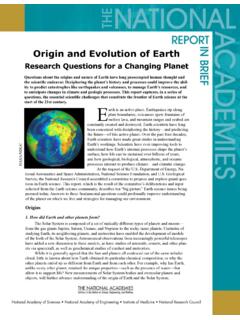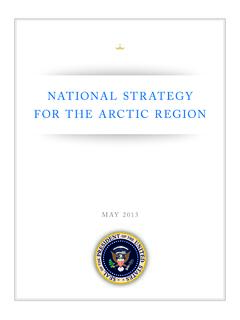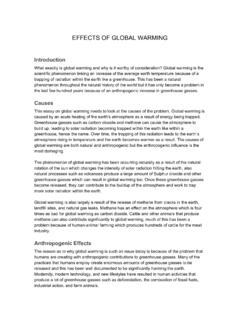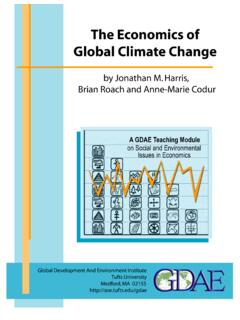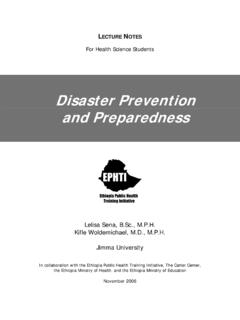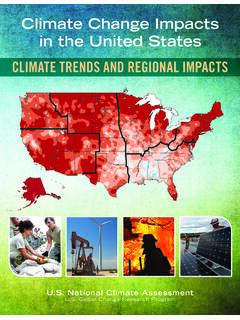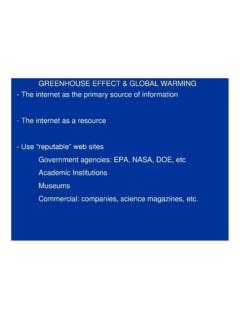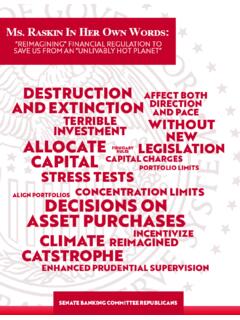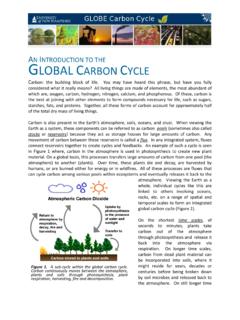Transcription of CHAPTER 15 BIOGEOCHEMICAL CYCLES - National Climate …
1 350 Climate Change Impacts in the United StatesCHAPTER 15 BIOGEOCHEMICAL CYCLESINFORMATION DRAWN FROM THIS CHAPTER IS INCLUDED IN THE HIGHLIGHTS REPORT AND IS IDENTIFIED BY THIS ICONR ecommended Citation for CHAPTER Galloway, J. N., W. H. Schlesinger, C. M. Clark, N. B. Grimm, R. B. Jackson, B. E. Law, P. E. Thornton, A. R. Townsend, and R. Martin, 2014: Ch. 15: BIOGEOCHEMICAL CYCLES . Climate Change Impacts in the United States: The Third National Climate Assessment, J. M. Melillo, Terese ( ) Richmond, and G. W. Yohe, Eds., global Change Research Program, 350-368. On the Web: Lead Authors James N. Galloway, University of Virginia William H. Schlesinger, Cary Institute of Ecosystem StudiesLead AuthorsChristopher M. Clark, Environmental Protection AgencyNancy B. Grimm, Arizona State UniversityRobert B. Jackson, Duke University Beverly E. Law, Oregon State UniversityPeter E. Thornton, Oak Ridge National LaboratoryAlan R. Townsend, University of Colorado Boulder Contributing AuthorRebecca Martin, Washington State University Vancouver351 Climate CHANGE IMPACTS IN THE UNITED STATESKey Messages1.
2 Human activities have increased atmospheric carbon dioxide by about 40% over pre-industrial levels and more than doubled the amount of nitrogen available to ecosystems. Similar trends have been observed for phosphorus and other elements, and these changes have major consequences for BIOGEOCHEMICAL CYCLES and Climate change. 2. In total, land in the United States absorbs and stores an amount of carbon equivalent to about 17% of annual fossil fuel emissions. forests and associated wood products account for most of this land sink. The effect of this carbon storage is to partially offset warming from emissions of CO2 and other greenhouse Altered BIOGEOCHEMICAL CYCLES together with Climate change increase the vulnerability of biodiversity, food security, human health, and water quality to changing Climate . However, natural and managed shifts in major BIOGEOCHEMICAL CYCLES can help limit rates of Climate CYCLES15 BIOGEOCHEMICAL CYCLES involve the fluxes of chemical elements among different parts of the Earth: from living to non-living, from atmosphere to land to sea, and from soils to plants.
3 They are called CYCLES because matter is always conserved and because elements move to and from major pools via a vari-ety of two-way fluxes, although some elements are stored in locations or in forms that are differentially accessible to living things. Human activities have mobilized Earth elements and accelerated their CYCLES for example, more than doubling the amount of reactive nitrogen that has been added to the bio-sphere since pre-industrial ,2 Reactive nitrogen is any ni-trogen compound that is biologically, chemically, or radiatively active, like nitrous oxide and ammonia, but not nitrogen gas (N2). global -scale alterations of BIOGEOCHEMICAL CYCLES are oc-curring, from human activities both in the and elsewhere, with impacts and implications now and into the future. Glob-al carbon dioxide emissions are the most significant driver of human-caused Climate change. But human-accelerated CYCLES of other elements, especially nitrogen, phosphorus, and sul-fur, also influence Climate .
4 These elements can affect Climate directly or act as indirect factors that alter the carbon cycle, amplifying or reducing the impacts of Climate change. Climate change is having, and will continue to have, impacts on BIOGEOCHEMICAL CYCLES , which will alter future impacts on Climate and affect our capacity to cope with coupled changes in Climate , biogeochemistry, and other factors. Key Message 1: Human-Induced ChangesHuman activities have increased atmospheric carbon dioxide by about 40% over pre-industrial levels and more than doubled the amount of nitrogen available to ecosystems. Similar trends have been observed for phosphorus and other elements, and these changes have major consequences for BIOGEOCHEMICAL CYCLES and Climate change. The human mobilization of carbon, nitrogen, and phosphorus from the Earth s crust and atmosphere into the environment has increased 36, 9, and 13 times, respectively, compared to geological sources over pre-industrial Fossil fuel burning, land-cover change, cement production, and the extraction and production of fertilizer to support agriculture are major causes of these Carbon dioxide (CO2) is the most abundant of the heat-trapping greenhouse gases that are increasing due to human activities, and its production dominates atmospheric forcing of global Climate However, methane (CH4) and nitrous oxide (N2O) have higher greenhouse- warming potential per molecule than CO2, and both are also increasing in the atmosphere.
5 In the and Europe, sulfur emissions have declined over the past three decades, especially since the mid-1990s, because of efforts to reduce air Changes in BIOGEOCHEMICAL CYCLES of carbon, nitrogen, phosphorus, and other elements and the coupling of those CYCLES can influence Climate . In turn, this 15: BIOGEOCHEMICAL CYCLES352 Climate CHANGE IMPACTS IN THE UNITED STATEScan change atmospheric composition in other ways that affect how the planet absorbs and reflects sunlight (for example, by creating small particles known as aerosols that can reflect sunlight). State of the Carbon Cycle The was the world s largest producer of human-caused CO2 emissions from 1950 until 2007, when it was surpassed by China. emissions account for approximately 85% of North American emissions of CO27 and 18% of global ,9 Ecosystems represent potential sinks for CO2, which are places where carbon can be stored over the short or long term (see Estimating the Carbon Sink ).
6 At the continental scale, there has been a large and relatively consistent increase in forest carbon stocks over the last two decades,10 due to recovery from past forest harvest, net increases in forest area, improved forest management regimes, and faster growth driven by Climate or fertilization by CO2 and , 11 The largest rates of disturbance and regrowth sinks are in southeastern, south central, and Pacific northwestern However, emissions of CO2 from human activities in the continue to increase and exceed ecosystem CO2 uptake by more than three times. As a result, North America remains a net source of CO2 into the atmosphere7 by a substantial and Fates of Reactive Nitrogen The nitrogen cycle has been dramatically altered by human activity, especially by the use of nitrogen fertilizers, which have increased agricultural production over the past half ,2 Although fertilizer nitrogen inputs have begun to level off in the since 1980,12 human-caused reactive nitrogen inputs are now at least five times greater than those from natural ,14,15,16 At least some of the added nitrogen is converted to nitrous oxide (N2O), which adds to the greenhouse effect in Earth s important characteristic of reactive nitrogen is its legacy.
7 Once created, it can, in sequence, travel throughout the environment (for example, from land to rivers to coasts, sometimes via the atmosphere), contributing to environmental problems such as the formation of coastal low-oxygen dead zones in marine ecosystems in summer. These problems persist until the reactive nitrogen is either captured and stored in a long-term pool, like the mineral layers of soil or deep ocean sediments, or converted back to nitrogen , 1 8 The nitrogen cycle affects atmospheric concentrations of the three most important human-caused greenhouse gases: carbon dioxide, methane, and nitrous oxide. Increased available nitrogen stimulates the uptake of carbon dioxide by plants, the release of methane from wetland soils, and the production of nitrous oxide by soil The release of carbon dioxide from fossil fuel burning in North America (shown here for 2010) vastly exceeds the amount that is taken up and temporarily stored in forests, crops, and other ecosystems (shown here is the annual average for 2000-2006).
8 (Figure source: King et al. 20127). Major North American Carbon Dioxide Sources and Sinks15: BIOGEOCHEMICAL CYCLES353 Climate CHANGE IMPACTS IN THE UNITED STATESP hosphorus and other elements The phosphorus cycle has been greatly transformed in the United States,19 primarily from the use of phosphorus fertilizers in agriculture. Phosphorus has no direct effects on Climate , but does have indirect effects, such as increasing carbon sinks by fertilizing plants. Emissions of sulfur, as sulfur dioxide, can reduce the growth of plants and stimulate the leaching of soil nutrients needed by Message 2: Sinks and CyclesIn total, land in the United States absorbs and stores an amount of carbon equivalent to about 17% of annual fossil fuel emissions. forests and associated wood products account for most of this land sink. The effect of this carbon storage is to partially offset warming from emissions of CO2 and other greenhouse gases.
9 Considering the entire atmospheric CO2 budget, the temporary net storage on land is small compared to the sources: more CO2 is emitted than can be taken up (see Estimating the Carbon Sink ).7,21,22,23 Other elements and compounds affect that balance by direct and indirect means (for example, nitrogen stimulates carbon uptake [direct] and nitrogen decreases the soil methane sink [indirect]). The net effect on Earth s energy balance from changes in major BIOGEOCHEMICAL CYCLES (carbon, nitrogen, sulfur, and phosphorus) depends upon processes that directly affect how the planet absorbs or reflects sunlight, as well as those that indirectly affect concentrations of greenhouse gases in the atmosphere. Figure Once created, a molecule of reactive nitrogen has a cascading impact on people and ecosystems as it contributes to a number of environmental issues. Molecular terms represent oxidized forms of nitrogen primarily from fossil fuel combustion (such as nitrogen oxides, NOx), reduced forms of nitrogen primarily from agriculture (such as ammonia, NH3), and organic forms of nitrogen (Norg) from various processes.
10 NOy is all nitrogen-containing atmospheric gases that have both nitrogen and oxygen, other than nitrous oxide (N2O). NHx is the sum of ammonia (NH3) and ammonium (NH4). (Figure source: adapted from EPA 2 011;13 Galloway et al. 2003;17 with input from USDA. USDA contributors were Adam Chambers and Margaret Walsh). Human Activities that Form Reactive Nitrogenand Resulting Consequences in Environmental Reservoirs15: BIOGEOCHEMICAL CYCLES354 Climate CHANGE IMPACTS IN THE UNITED STATESC arbonIn addition to the CO2 effects described above, other car-bon-containing compounds affect Climate change, such as methane and volatile organic compounds (VOCs). As the most abundant non-CO2 greenhouse gas, methane is 20 to 30 times more potent than CO2 over a century timescale. It accounted for 9% of all human-caused greenhouse gas emissions in the United States in 2011,8 and its atmospheric concentration to-day is more than twice that of pre-industrial ,25 Meth-ane has an atmospheric lifetime of about 10 years before it is oxidized to CO2, but it has about 25 times the global warming potential of CO2.
